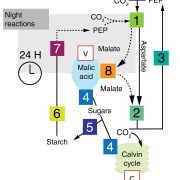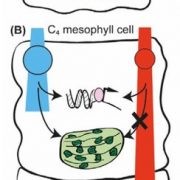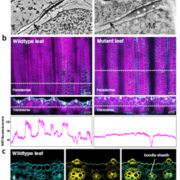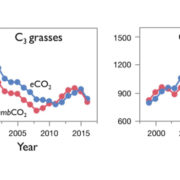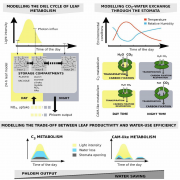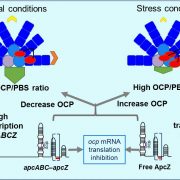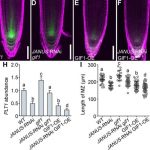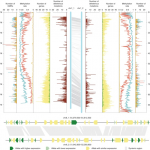The dependency of red Rubisco on its cognate activase for enhancing plant photosynthesis and growth (Proc. Natl. Acad. Sci. USA)
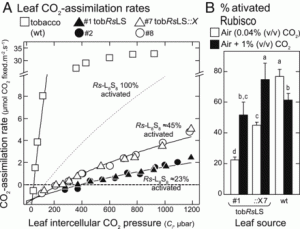 The rate of carboxylation by Rubisco versus the rate of the competing oxygenation reaction limits photosynthesis in some conditions, so many researchers are investigating ways to enhance Rubisco. Rubisco is not limited to green plants but can be found in other lineages including red algae and photosynthetic bacteria other than cyanobacteria. The “red” Rubisco (found in red algae and some proteobacteria) are characterized by a higher affinity for the carboxylation reaction, and so provide an attractive route for photosynthetic enhancement. Here, Gunn et al. introduced into tobacco and E. coli a codon-optimized red Rubisco operon from the photosynthetic bacterium Rhodobacter sphaeroides and showed that the enzyme (a type IC Rubisco) is correctly assembled and functional. The addition of the bacteria’s Rubisco activase enzyme (a metabolic repair chaperon) increased Rubisco activity even more. The fact that similar results were found in E. coli and tobacco indicates that products of directed evolution can be prescreened in the simpler expression system. These findings provide new avenues or the development of Rubisco enhancement in crop plants. (Summary by Mary Williams @PlantTeaching) Proc. Natl. Acad. Sci. USA 10.1073/pnas.2011641117
The rate of carboxylation by Rubisco versus the rate of the competing oxygenation reaction limits photosynthesis in some conditions, so many researchers are investigating ways to enhance Rubisco. Rubisco is not limited to green plants but can be found in other lineages including red algae and photosynthetic bacteria other than cyanobacteria. The “red” Rubisco (found in red algae and some proteobacteria) are characterized by a higher affinity for the carboxylation reaction, and so provide an attractive route for photosynthetic enhancement. Here, Gunn et al. introduced into tobacco and E. coli a codon-optimized red Rubisco operon from the photosynthetic bacterium Rhodobacter sphaeroides and showed that the enzyme (a type IC Rubisco) is correctly assembled and functional. The addition of the bacteria’s Rubisco activase enzyme (a metabolic repair chaperon) increased Rubisco activity even more. The fact that similar results were found in E. coli and tobacco indicates that products of directed evolution can be prescreened in the simpler expression system. These findings provide new avenues or the development of Rubisco enhancement in crop plants. (Summary by Mary Williams @PlantTeaching) Proc. Natl. Acad. Sci. USA 10.1073/pnas.2011641117


